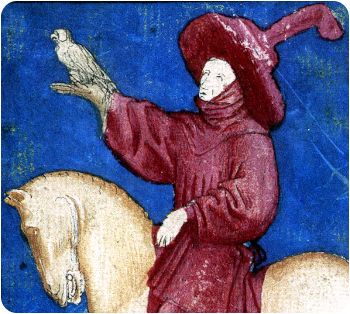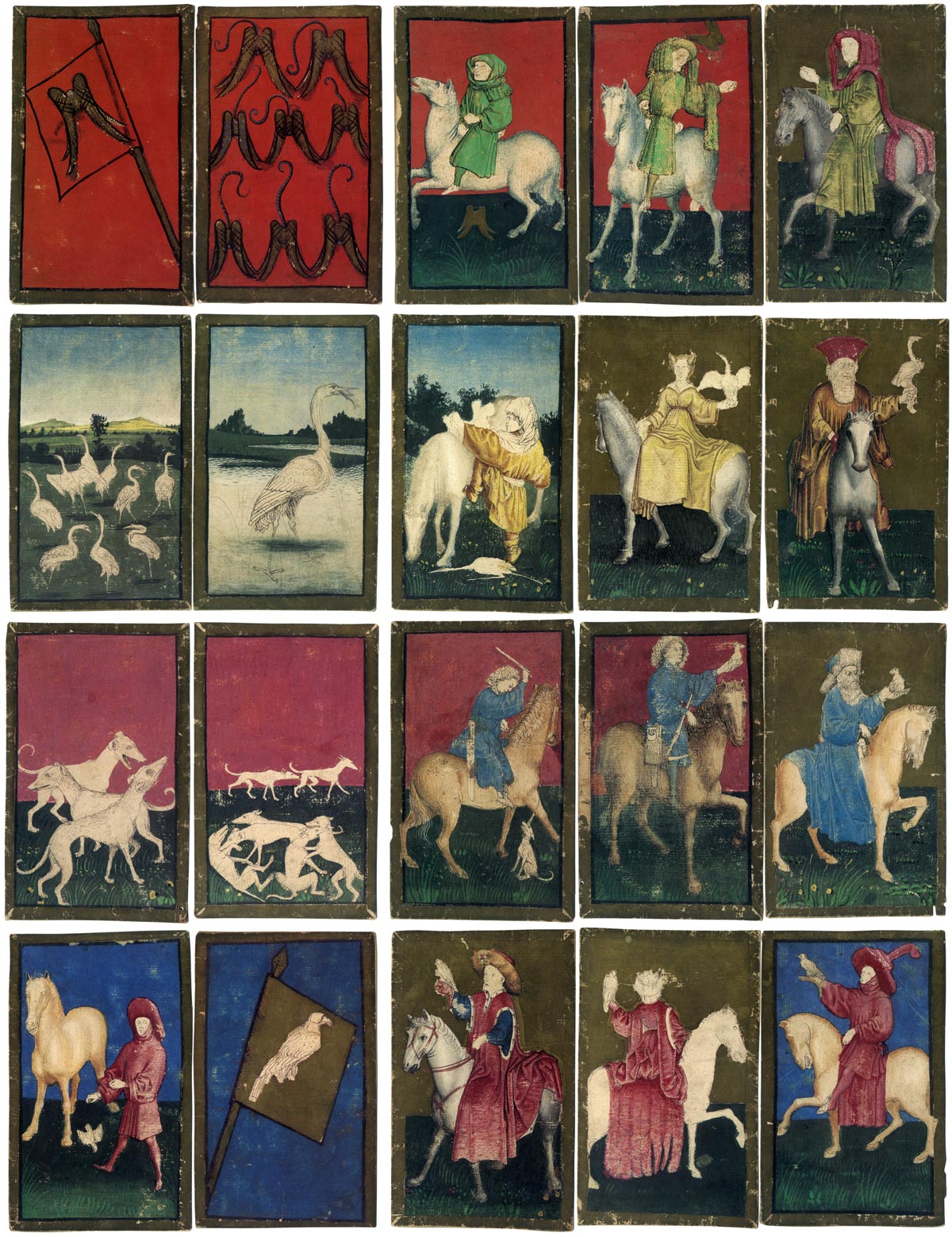The Princely Hunting pack, c.1440
The Princely Hunting Pack, c.1440/45, is attributed to Konrad Witz and his workshop in Basle.

The Ambras Court Hunting pack, c.1445
Ambraser Hofjagdspiel
The Ambraser Hofjagdspiel, c.1440/45, is attributed to Konrad Witz and his workshop in Basle. It was found in a collection at the castle of Ambras (Innsbruck, Austria) in the 16th century, hence its name ‘The Court Hunting pack of Ambras’. The pack originally consisted of fifty-six cards in four suits, and the suit symbols are lures, herons, hounds & falcons... which all relate to the theme of heron hunting. The thematic consistency in the pack is remarkable and must rank as the culmination of iconographic treatment of the hunting theme in playing cards.

Above: cards from the facsimile edition published by Piatnik, Vienna, 1995, the original of which is in the Vienna Museum of Art History.
The pack originally consisted of fifty-six cards in four suits, size 9.5 x 15.6 cm, painted red on the reverse. The cards are executed in water colours and paints over black ink drawings on paper - they are not printed or mechanically produced in any way. Several layers of paper have been glued together to give the cards the necessary thickness. As was the practice with early Italian cards, the back paper has been cut slightly larger allowing the edges to fold over to the front, forming a border around the fronts of the cards (sometimes this border obscures part of the drawings). The suit symbols are hounds, herons, lures & falcons. The court hierarchy consists of four court cards in each suit, unnumbered and without titles, all mounted on horseback: King and Queen (with brushed gold backgrounds), Upper Knave & Lower Knave (with backgrounds matching their respective number cards). The ‘number’ cards are also unnumbered, but run from 1 - 9, with a banner as 10. Banner 10s were often associated with South German cards in the fifteenth and sixteenth centuries, and still are found today in Switzerland. See also: The Pack of Cards by the South German Engraver.

The cards are notable for their carefully devised colour scheme and the consistent internal structure of the pack which extends to the clothing as well as background colours of each suit. Another feature is the thematic consistency of the four suits which all relate to the theme of hunting, a pastime which was the prerogative of the nobility for whom the pack was probably designed. Not all the numeral cards are arranged in neat, formal rows, but in some cases the artist has illustrated the animals' natural behaviour and arranged them in a haphazard, informal manner. These considerations, added to the cost of a luxury pack produced in the workshop of Konrad Witz, suggest that these cards were intended for courtly patrons, not for ordinary people. Furthermore, the cards can hardly have been used for play: they show no sign of wear and are unfinished... perhaps because the Herons and Hounds suit number cards were poorly suited to the practical requirements of card playing.
A 56 card pack, of course, is similar to Italian Tarocchi packs without the 22 trump cards. Four court cards are found also in other early packs, such as the two packs by the Master E.S., but most packs had only three court cards per suit. In this pack, however, the Kings and Queens do not wear crowns but instead wear exotic headgear.
In the years before the Renaissance reached the North, German bourgeois art began to embrace the external physical world: human figures and animals are depicted in these playing cards with realistic skies and landscape backgrounds, shadows and light-and-shade effects. In several ways these cards depart from the typical conventions of fifteenth century playing card design and we may regard Konrad Witz and his apprentices as innovators in their field. See also the hand-painted "Stuttgart Cards" and copper-engraved cards by the Master of the Playing Cards and Master of the Banderoles.
Reference
Kunsthistorisches Museum Vienna: Ambraser Hofjagdspiel►

By Simon Wintle
Member since February 01, 1996
Founder and editor of the World of Playing Cards since 1996. He is a former committee member of the IPCS and was graphics editor of The Playing-Card journal for many years. He has lived at various times in Chile, England and Wales and is currently living in Extremadura, Spain. Simon's first limited edition pack of playing cards was a replica of a seventeenth century traditional English pack, which he produced from woodblocks and stencils.
Leave a Reply
Your Name
Just nowRelated Articles

Les Jeux de Pastor
Striking designs by Edouard Pastor focusing on the heads of figures from the medieval period.

Le Jeu des Personnages de l’Antiquité et du Moyen-Age
Edouard Pastor’s designs in black and gold inspired by Antiquity and the Middle Ages.

Rouen Pattern - Portrait Rouennais
An attractive XV century French-suited design from Rouen became the standard English & Anglo-America...

Heathen Divinities
Handmade playing cards from the British Museum depicting classical Greek and Roman gods and goddesse...

Hand-drawn set of 52 playing cards
An imaginatively hand-drawn set of 52 playing cards by an amateur artist, 18th century.

Grunwald 1410 – The Battle of Tannenberg
Details from the famous painting of the Battle of Grunwald (1410) by the Polish painter Jan Matejko....

Unimog UX 100
Cartoons promoting the Unimog UX 100, a small truck produced by Mercedes-Benz.

Juristenskat
Caricatures of lawyers and judges by Philipp Heinisch for HEEL Verlag.

Battles in Mexico, 1847
Uncut proof sheet with Mexican Battle scenes on the aces and portraits of American generals on the c...

Medieval Heraldry
53 cards of original hand painted prints taken from medieval manuscripts.

Double-ended German-suited pack by Josef Glanz, Vienna.
From the British Museum collection.

Ganjifa - Playing Cards from India
Indian playing cards, known as Ganjifa, feature intricate designs with twelve suits and are traditio...

Classification of Numeral Card Designs in French-suited packs
The classification of numeral cards in French-suited packs, covering various pip designs in over 400...

Medizin Skat
Promotional pack for a hospital group in the Saarland, with non-standard suits and courts designed b...

The Henry Hart Puzzle
Explore the intricate history and unique design variations of Henry Hart's playing cards, tracing th...

Opernkarte I
Humorous designs by Peter Becker on the theme of the Opera.
Trending Articles
Popular articles from the past 28 days



 Your comment here. Your comment here. Your comment here. Your comment here. Your comment here. Your comment here. Your comment here. Your comment here. Your comment here. Your comment here. Your comment here. Your comment here. Your comment here. Your comment here. Your comment here. Your comment here. Your comment here. Your comment here. Your comment here. Your comment here. Your comment here. Your comment here. Your comment here. Your comment here. Your comment here. Your comment here. Your comment here. Your comment here. Your comment here. Your comment here. Your comment here. Your comment here.
Your comment here. Your comment here. Your comment here. Your comment here. Your comment here. Your comment here. Your comment here. Your comment here. Your comment here. Your comment here. Your comment here. Your comment here. Your comment here. Your comment here. Your comment here. Your comment here. Your comment here. Your comment here. Your comment here. Your comment here. Your comment here. Your comment here. Your comment here. Your comment here. Your comment here. Your comment here. Your comment here. Your comment here. Your comment here. Your comment here. Your comment here. Your comment here.